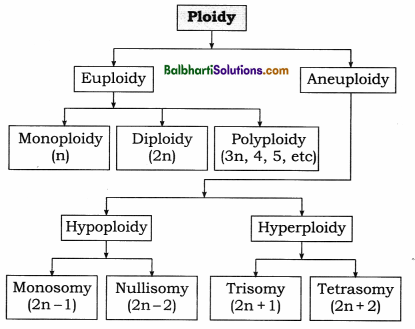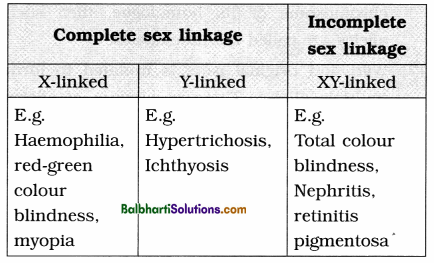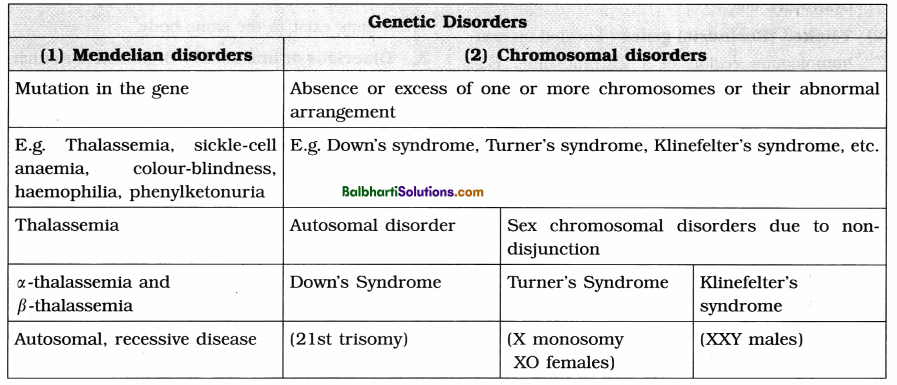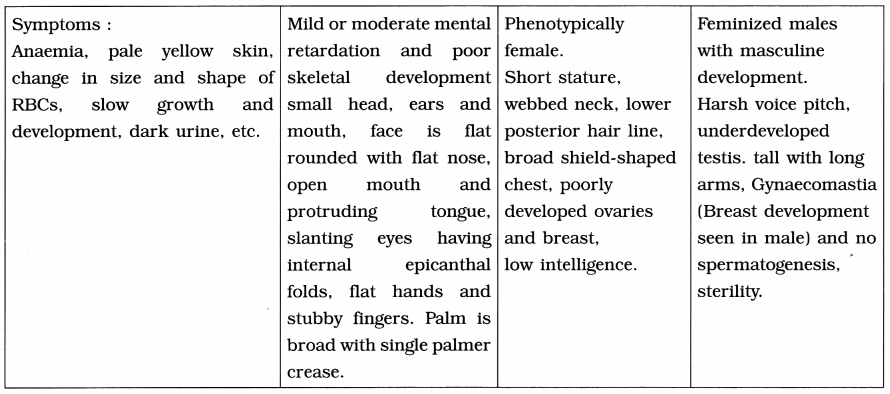By going through these Maharashtra State Board 12th Science Biology Notes Chapter 3 Inheritance and Variation students can recall all the concepts quickly.
Maharashtra State Board 12th Biology Notes Chapter 3 Inheritance and Variation
Chromosomes and Mechanism of inheritance-
1. Heredity or inheritance : The transmission of genetic information from generation to generation.
2. Gregor Mendel : He used hybridization techniques and gave explanation for heredity.
He postulated principles of heredity.
3. Correns was other contemporary German botanist.
Note : Carl Correns discovered principles of heredity independently and verified work of Mendel by experimenting on other model organisms. He did not propose fundamental laws of heredity as mentioned in textbook. Laws of heredity were given by Mendel.
4. Mendel gave the term factors, which is now 5 known as genes.
5. Reasons for Mendel’s success :
- Carefully planned experiments.
- Large sample of study. Meticulous recordings which gave the ratios.
- Well-chosen contrasting characters which were recognizable.
- Each character controlled by single factor.
- Dominance and recessiveness among the pair of characters.
![]()
6. Seven pairs of contrasting characters of pea plant studied by Mendel were :
| Character | Dominant | Recessive |
| Seed shape | Round | Wrinkled |
| Seed colour | Yellow | Green |
| Pod shape | Inflated | Constricted |
| Pod colour | Green | Yellow |
| Flower colour | Purple | White |
| Flower location | Axial | Terminal |
| Plant height | Tall | Dwarf/Short |
Genetic Terminology-
- Character : Specific feature that an organism possesses.
- Trait : An inherited character with its variant form that can easily be seen. E.g. Tall or dwarf.
- Factor : Unit of heredity responsible for the inheritance and expression of a genetic character. Initially considered to be in a particulate form.
- Gene : Specific segment of DNA responsible for the inheritance and expression of that character.
- Alleles or Allelomorphs : The two or more alternative forms of a given gene (factor). They are present on the identical loci on homologous chromosomes.
- Dominant : An allele capable of expressing its trait even in the presence of an alternative allele is called a dominant allele. In heterozygous condition, dominant ones always show their expression. E.g. T allele.
- Recessive : An allele that is not expressed in the presence of an alternative allele is called recessive allele. In heterozygous condition, they are never expressed. They are expressed only when they are in homozygous condition. E.g. T allele.
- Phenotype : The external appearance of an organism which can be easily seen for any trait is called its phenotype. E.g. Tallness or dwarfness of pea plant. The ratio of phenotypes, i.e. external appearance of offspring produced in F2 and subsequent generation. E.g. 3 Tall: 1 dwarf is phenotypic ratio in monohybrid cross.
- Genotype : Genetic constitution of an organism which decides the trait is called genotype. E.g. TT / Tt / tt are genotypes. The ratio of genotypes produced in the F<sub>2</sub> and subsequent generation is called genotypic ratio. E.g. 1 TT : 2Tt : 1 tt. (1:2:1 is genotypic ratio for monohybrid cross.)
- Homozygous (pure): In homozygous condition, there are identical alleles for a particular trait. Homozygous produces only one type of gametes. E.g. TT (tall) or tt (dwarf).
- Heterozygous: In heterozygous condition, there are pairs of contrasting alleles for a particular trait. Heterozygous or hybrid produces two types of gametes, E.g. Tt.
- Pure line: An individual or a population which is homozygous for one or more traits, is called pure line.
- Monohybrid: When one trait is considered during inheritance, it is called monohybrid. A cross considering only one heritable trait is called monohybrid cross. E.g. cross of pure tall and pure dwarf plants.
- Dihybrid: When two traits are considered during inheritance, it is called dihybrid.
A cross between parents differing in two heritable traits, is called dihybrid cross. - F1 generation / First filial generation: First generation formed by mating of pure parents having contrasting characters. E.g. Progeny of TT x tt.
- F2 generation: Generation obtained by self¬breeding F1 organisms, is called F2 generation. E.g. Progeny of Tt x Tt.
- Punnett square/checker board: A probability table representing different permutations and combination of fertilization between gametes of the opposite mating types.
- Homologous Chromosomes: Identical chromosomes which are morphologically, genetically and structurally similar are homologous chromosomes.
- Back cross: A cross of F1 progeny with any of the parents (e.g. F1 tall x pure tall; F1 tall x pure dwarf i.e. Tt x TT or Tt x tt).
- Test cross: A cross of F1 progeny with homozygous recessive parent
(e.g. F1 tall x pure dwarf i.e. Tt x tt).
Mendel’s Laws of Inheritance-
- Law of Dominance: When two homozygous individuals with one or more sets of contrasting characters are crossed, the alleles (characters) that appear in F1 are dominant and those which do not appear in F1 are recessive.
- Law of segregation or Law of purity of gametes: When 1 hybrid forms gametes, the alleles segregate from each other and enter in different gametes. The gametes formed are pure because they carry only one allele each (either dominant one or recessive one.)
- Law of Independent Assortment: When hybrid possessing two (or more) pairs of contrasting factors or alleles forms gametes, the factors in each pair segregate independently of the other pair.
Back cross Test cross-
- Back cross: Back cross is the cross between F1 individual with one of the parent. (Either recessive or dominant).
- Test cross: Test cross is the cross of F1 hybrid with the homozygous recessive parent.
Deviations from Mendel’s findings-
I. Mendel’s experiments gave the following generalizations:
- Single trait due to single gene which has two alleles.
- Two alleles interact with each other in which one allele is completely dominant.
- Factors or genes for different traits are present on different chromosomes and they show independent assortment.
2. Later, different deviations were noted by the scientists who worked in post-Mendelian era. These findings form Neo-Mendelism.
3. The deviations from Mendel’s findings are of following types:
- Phenomena of co-dominance and incomplete dominance: Shown by single trait due to single gene but its two alleles show interactions.
- Multiple allelism: Single trait shown by single gene which has more than two alleles.
- Polygenic inheritance: Single trait due to more than one gene which show interactions which are either epistastic or additive effect.
- Pleiotropy: Many traits which are influenced by a single gene.
4. Gene interactions: When phenotypic expression of a gene is modified or influenced by the other gene, then it is called gene interactions.
- Intragenic interactions: Interactions between the alleles of same gene. E.g. incomplete dominance and co-dominance. Also seen in the multiple allele series of a gene.
- Intergenic (non-allelic) interactions: Interactions between the alleles of different genes present on the same or different chromosomes E.g., Pleiotropy, polygenes, supplementary and complementary genes.
![]()
5. Incomplete dominance: When both the alleles express themselves partially then it is called the incomplete dominance. Unlike as in complete dominance, here one allele cannot completely suppress the expression of the other allele. Thus there is formation of an intermediate expression in the F1 hybrid.
E.g. the flower colour of Mirabilis jalapa.
- Red-flowered (RR) plant x White-flowered (rr) plant,
- F1 offspring: Pink (Rr) flowers.
Genotypic ratio – 1 RR : 2 Rr : 1 rr
Phenotypic ratio – 1 Red : 2 Pink : 1 White
6. Co-dominance: When both the alleles of an allelomorphic pair express themselves equally in F1 hybrids then it is called co-dominance. Alleles that express themselves equally independently in hybrids, are co-dominant alleles.
E.g. Coat colour in cattle.
- Red coat (RR) x white coat (W W).
- F1 hybrids (RW) : Roan, (mixture of red and white). Both traits expressed equally.
In F2 generation red (RR) : roans (RW) : white (WW) =1:2:1. - Co-dominance shows the genotypic and phenotypic ratios identical.
7. Multiple alleles :
- When more than two alleles of a gene in a population occupy the same locus on a chromosome or its homologue, then such alleles are called multiple alleles.
- Wild and original gene is mutated to form multiple alleles. There is a series of alleles which show dominance, co-dominance or incomplete dominance with the other recessive alleles among them. The most dominant is the wild type.
E.g. (1) Size of wings in Drosophila. From normal wings to vestigial wings (vg) in homozygous condition. (2) A, B, O blood groups in human beings.
8. Pleiotropy:
- Pleiotropic gene is the single gene that controls two {or more) different traits.
This phenomenon is called pleiotropy or pleiotropism. - Phenotypic ratio : 1 : 2 instead of 3:1 because of the death of recessive homozygote.
- E.g. Sickle-cell anaemia, is caused by a gene Hbs.
Normal or healthy gene is dominant : HbA
Heterozygotes are carriers (HbA/Hbs). They show signs of mild anaemia.
Homozygotes with recessive gene Hbs die due to severe anaemia.
Thus, the gene for sickle-cell anaemia is lethal in homozygous condition and produces sickle-cell trait in heterozygous carrier.
(4) TWo different expressions are produced by a single gene. A marriage between two carriers will produce normal carriers and sickle-cell anaemic children in 1 : 2 : 1 ratio.
Chromosomal Theory of Inheritance
- Hugo de Vries, Correns and von Tschermak, independently rediscovered Mendel’s work on the inheritance of traits in 1900.
- Walter Sutton and Theodore Boveri (1903) put forth theory of chromosomal theory of inheritance after studying behaviour of meiotic chromosomes.
Chromosomes
(Chromo = colour, soma = body)
1. Carriers of heredity, chemically they are made up of DNA, histone and non-histone proteins.
- The term ‘Chromosome’ was coined by W. Waldeyer (1888).
- Chromosome number is specific for every species.
2. Ploidy: The degree of repetition of the primary basic number of chromosomes (i.e. ‘x’) in a cell.
- Euploidy : Euploidy is the condition in which the chromosome number in a cell is the exact multiple of the primary basic number.
- Euploids are further divided into monoploid/haploid (n), diploids (2n), triploids (3n), tetraploid (4n), etc.
- Aneuploidy : Aneuploidy is the condition in which the chromosome number shows either addition or deletion by one or more.

![]()
3. Structure of chromosome :
Parts of a typical chromosome :
- Two chromatids arms joined together at centromere. Chromatid arm bears long, unbranched, slender, highly coiled DNA thread called chromonema.
- Centromere or primary constriction : Has kinetochore. (Disk shaped structure at which i spindle fibres are attached during cell division.)
- Secondary constriction : At secondary constriction I, nucleolus becomes organized during interphase.
- A satellite body (SAT body) attached at secondary constriction II.
- Telomeres : The ends of chromosomes.
4. Types of chromosomes : Classified as per 5 the position of centromere :
- Acrocentric (j-shaped),
- Telocentric (i-shaped),
- Submetacentric (L-shaped) and
- Metacentric (V-shaped).
5. Sex chromosomes : Sex chromosomes or allosomes are responsible for the determination of sex.
Linkage and Crossing Over
1. Linkage :
- Tendency of two or more genes to be inherited together is called linkage. The genes showing linkage are called linked genes.
- Bateson and Punnett discovered linkage in ; plants.
- T. H. Morgan discovered linkage in animals.
- Types of linkage : Complete linkage and Incomplete linkage :
(i) Complete linkage : E.g. seen in X chromosome of Drosophila males.
(ii) Incomplete linkage : E.g. seen in colour : and shape of grain of Zea mays. - Linkage Groups : All the linked genes in a particular chromosome.
- The number of linkage groups of a particular species is equal to its haploid number of chromosomes.
2. Sex – linkage and Sex – linked inheritance

3. Crossing Over:
- Process of formation of recombinations of genes by interchanging and exchanging the segments of non-sister chromatids of homologous chromosomes is called crossing over. Crossing over takes place in pachytene of prophase-I of meiosis.
- Morgan coined the term crossing over.
- The mechanism of crossing over : There are four sequential steps such as synapsis, tetrad formation, crossing over and terminalisation.
- Due to crossing over, variations are produced which act as raw material for natural selection and thus helps in evolution.
4. Morgan’s Experiments showing linkage and crossing over :
- (1) Drosophila melanogaster used for genetic experiments because :
- Easily cultured in laboratory.
- Life span is short of about two weeks.
- High rate of reproduction.
- Morgan explained the principle of linkage, sex linkage and crossing over.
- According to his experiments :
- Genes grouped on the same chromosome are strongly linked. Recombinations among them are only 1.3%.
- Genes present far away from each other on chromosome are loosely linked and hence show more 37.2% recombinations.
Autosomal Inheritance-
- Somatic cells of humans have 23 pairs of ; chromosomes. (2n)
- 22 pairs are autosomes and 1 pair is sex chromosome.
- Autosomes are concerned with bodily characters while sex chromosomes decide the sex of the individual.
- Autosome linked traits show autosomal i inheritance. TWo types : (1) Dominant (Widow’s peak and Huntington’s disease) : (2) Recessive [Phenylketonuria (PKU), Cystic I fibrosis and Sickle-cell anaemia].
Sex-Linked Inheritance-
1. Sex-linked genes are present on non-homologous region of sex chromosomes.
2. Their inheritance is called sex-linked inheritance.
3. Types of sex-linked genes : X-linked genes, Y-linked genes and X-Y linked genes.
- X-linked (sex-linked) genes : Located on non-homologous region of X chromosome. X-linked recessive genes show criss-cross i inheritance. E.g. Haemophilia, colour ; blindness, night blindness, myopia, muscular : dystrophy, etc.
- Y-linked (Holandric) genes : Located on non- homologous region of Y chromosome. E.g. Hypertrichosis.
- X-Y-linked genes : Located on homologous : region of X and Y chromosome and hence : called incompletely sex linked genes. E.g.
Total colour blindness, nephritis and retinitis pigmentosa. - Red green Colour blindness : X-linked recessive disorder. Inability to distinguish red and green colours.
Genotypes of male and female individuals for colour blindness are as follows :

4. Haemophilia (Bleeder’s disease): X-linked recessive disorder. Blood clotting does not take place due to lack of (VIII or IX) clotting factors in blood.
Genotypes of male and female individuals for haemophilia are as follows :

Remember : XhXh combination is lethal, such females do not survive.
![]()
Sex Determination-
- Bisexual or hermaphrodite or monoecious : The organisms in which both types of sex organs exist in the same body.
- Dioecious or unisexual : Organism has either male or female reproductive organs.
- German biologist, Henking in 1891, gave the concept of “X-body”. It was later understood that it is X chromosome.
- Sex Determination :
(1) Chromosomal :

Note : The diploid autosomal number may be different for different birds. It should be remembered as AA and not 2n (as given in Textbook page no. 65, Fig. 3.15). Because 2n will be diploid chromosome number including autosomes and sex chromosomes.
(2) Environmental : Seen in Bonellia viridis
- Larva grown in vicinity of adult female grows into male.
- Larva which drifts away from adult female grows into female.
Genetic Disorders-


Know your scientist :
Thomas Hunt Morgan
Contributions :
- Chromosomal theory of heredity
- Introduction of Drosophila in genetic research.
- Principle of linkage, sex linkage and crossing over.
- Key role in the field of genetics.
- Nobel prize for Physiology and medicine (1933)